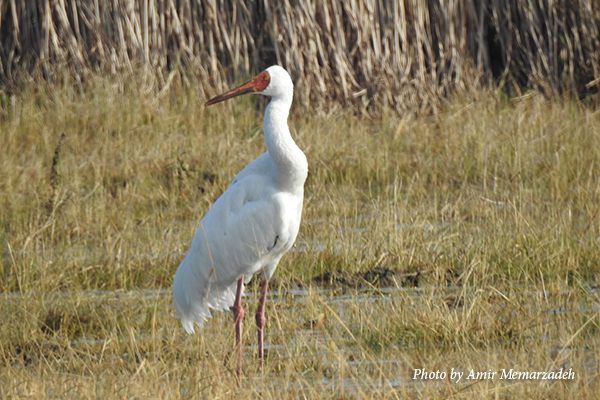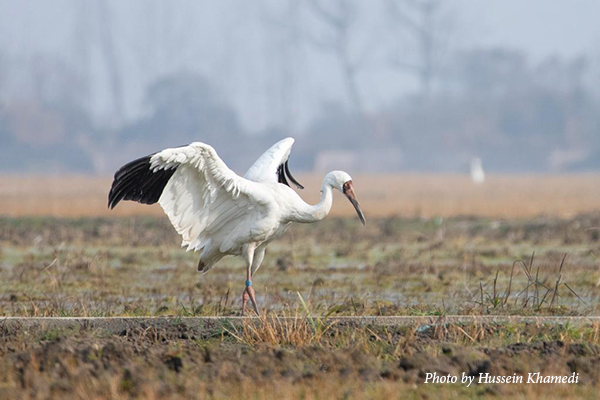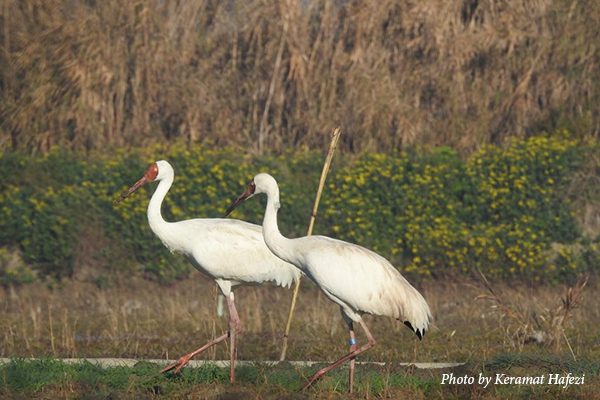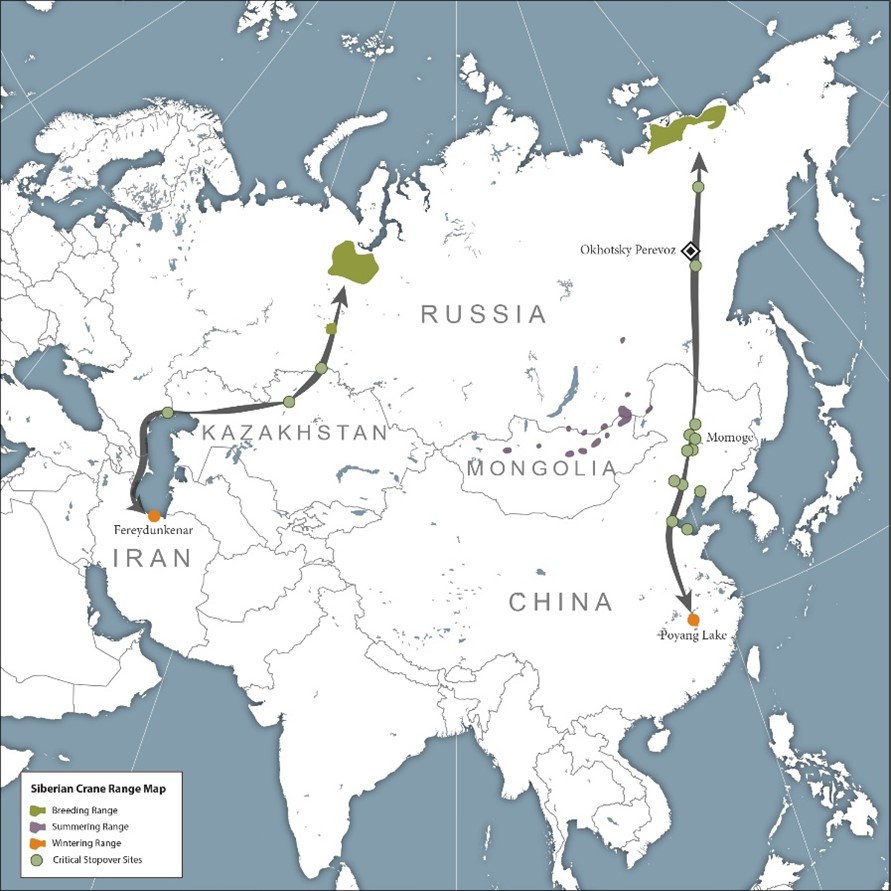“This is the story of the last of the western population of Siberian Cranes, a group discovered by Dr. Ali Ashtiani in 1978. They numbered 12-14 cranes and inhabited a wetland complex where local people trapped wild ducks and geese. In 1985, Russian colleague, Dr. Yuri Markin, mapped the complex migration route and discovered the breeding grounds by attaching a satellite radio transmitter to a male crane in Iran. During the 1990s, the population declined, perhaps attributed to widespread hunting following the collapse of the USSR and consequent food shortages for people along much of the migration route. For 15 years, only a single male named Omid appeared each autumn in Iran.” ~ George Archibald, International Crane Foundation Co-Founder
A single, snow-white Siberian Crane named Omid, Persian for Hope, has wintered alone in northern Iran for 15 years. As the last known survivor of his species’ western population, Omid is a celebrity for nature lovers in Iran and worldwide. Biologists identify Omid as a male based on his size and calls.
Since 2006, Omid has been flying alone from his breeding grounds in Siberia to his wintering grounds in Iran. The future of the population rests on his shoulders, but without a mate, there is no hope of his breeding.
That changed in late January when a female Siberian Crane was flown from the breeding center at the Cracid Breeding and Conservation Center (CBCC) in Zutendaal, Belgium, in the hopes that she would join Omid. The bonding of these two birds represents the last hope for the western population of this Critically Endangered species.

In all, a few thousand Siberian Cranes still live in the wild. Historically, there were three migration routes of the Siberian Crane in Asia. The central population, which wintered in India, has been extinct since 2002. The eastern population, wintering in China, now has around 5,000 birds, but their habitat is threatened by dam construction, loss and degradation of wetland habitat, and climate change. And then there is the western population, of which Omid is the last survivor.
The CBCC has had success with reintroducing endangered birds in South America. “Through a United Nations Environmental Program Convention on Migratory Species program, we became involved in a project to save the Siberian Crane,” says Geer Sheres, who since 1994 has run the CBCC in the forests of Zutendaal with Luud Gerrlings. Dozens of cranes of different species live in large aviaries in Zutendaal. “A large portion of the captive population of Siberian Cranes kept in a protected environment is here.”

No wonder the team found a possible mate for Omid in Zutendaal. On January 25, Roya – Persian for Dream – was flown to Tehran. She was met and is being carefully looked after by the Iranian Department of the Environment, which worked closely with CBCC to obtain the permits to ship an endangered species internationally. From the airport, she was taken to the Fereydoonkenar Marsh, Omid’s winter habitat. After a journey of some 24 hours, she was kept for three days in a special aviary built for her to get used to her new environment.

The 7-year-old female selected is a strong candidate for this experiment. She was raised by her parents and is well-imprinted on her species. She has paired and successfully raised young in captivity. When released near the lone male in Iran, she sought his company. The male has bonded with released females in past years and is likely to bond with this experienced female.
Around March 10, Omid will leave again for his breeding grounds in Siberia, a journey of thousands of kilometers. “So Roya has six weeks to develop her wing strength,” Scheres said. “In cranes, migration behavior is passed on from generation to generation. The young fly once with their parents and learn the route. Omid is the only one who still knows the western route. The risk of losing this ancient knowledge is another reason why Roya is so important.”
It is essential that the birds are left undisturbed to allow Roya adequate time to learn to feed on natural food, build up her fat reserves, and develop the athletic flight strength required to undertake the lengthy and arduous spring migration. The Iran Department of the Environment has appointed guards and is restricting access to the area to protect the birds from disturbance. Well-intentioned birdwatchers and media along the migration route are requested to avoid approaching the birds for fear the nervous male will be easily spooked and leave the female behind. Even minor disturbances can prevent the female from getting essential rest and time to feed during migration.
The release provides a unique and fleeting opportunity for the male to teach his mate and offspring the traditional migration route and stopover sites that will be lost when he is gone. If this can be done successfully, it leaves the door open for future releases of larger numbers of birds to re-establish a genetically and demographically viable population. This potential project builds on a multi-national “Flight of Hope” project led by colleagues at the All-Russian Research Institute for Nature Conservation and the Rare Crane Breeding Center at the Okskii Biosphere Reserve aimed at developing release techniques and protecting habitat along the migration route.
The wintering site for the Siberian Cranes in Iran was also secured through a major international project from 2003-2009 coordinated by the International Crane Foundation and led in Iran by the Department of Environment, helping to sensitize surrounding communities and establish improved protection for the cranes.

The migration route of the western population of Siberian Cranes is complex and challenging, with the Iranian birds flying north along the west coast of the Caspian Sea, turning east along the north shore of the Caspian instead of continuing north along the Volga River, and then flying along the eastern side of the Ural Mountains to their breeding grounds near Uvat in Russia. The male has also learned safe places to rest and feed during the long migration.
In Zutendaal, they hope for success.” But it remains an experiment,” says Luud Geerlings. “There are always risks, such as illegal hunting. If Omid and Roya fly to Siberia together, the first step will be successful. And hopefully, they will then return after the summer with one or two young.” In the next stage, more Siberian Cranes could move from Zutendaal to Iran.
“We greatly respect the work of the CBCC,” says Claire Mirande, Asia Program Manager at the International Crane Foundation. “They have successfully bred most species of cranes with a significant focus on Siberian Cranes. They have also successfully reintroduced six species of cracids in South America that would have been lost without their intervention. Their support for this effort is greatly appreciated.”
“If Omid and Roya migrate to the breeding grounds, raise a juvenile and return as a family of three to Iran, we can rejoice that a ray of light beams in the darkness for the return of these magnificent white cranes to a flyway they have used for thousands of years,” reflects George Archibald, Co-Founder of the International Crane Foundation.

Story submitted by Claire Mirande, Asia Program Manager. Learn more about our work in East Asia here.
